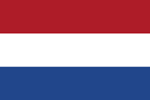The Netherlands

The Netherlands being the most densely populated country of the world has very interesting cities, beautifully preserved nature, and varied landscape, always fresh through the wind from the sea. This is the country, where light astonishes the visitor. No wonder, that the Dutch gave human civilization several important painters.
Official Name
Kingdom of the Netherlands (Dutch: Koninkrijk der Nederlanden). The Kingdom of the Netherlands consists of the Netherlands and its overseas islands - Netherlands Antilles and Aruba.
The Netherlands or Holland?
Talking about the Netherlands, people often incorrectly call it Holland. In fact, only the central part of the Netherlands is geographically named Holland. This part of the country consists now of two provinces Noord Holland (North Holland) and Zuid-Holland (South Holland). This is the region with important cities as Amsterdam, Rotterdam, The Hague (Den Haag), Delft, Leiden and Haarlem.
Geography and Climate
The Netherlands is located in North Western Europe, at the West and North-West coastline the North Sea; the country borders with Belgium from the South and Germany from the East and Northeast. Through its long North Sea coast (451 km) the climate of the Netherlands is a typical mild maritime climate, wet and mild, winters are rarely strong, summer is never very hot.
Provinces of the Netherlands
The Netherlands are traditionally divided into 12 provinces, which have their own capital, own self-rule and administration. Each of these provinces has very different sphere, different history, and different traditions. Thus, more than in any other country of Europe, richness of the Netherlands lays in its diversity.
Population and Languages
The Netherlands is populated in 81% by Caucasian Dutch population of Germanic or Gallo Celtic descent. Contrary to the popular ideas, more Dutch are catholic 31% than protestant 21%. In the Netherlands, women slightly exceed the male population. Dutch is an official language, spoken by almost total of the population, except for the expats coming from the Anglo-Saxon countries.
Short history of the Netherlands
Feeling of the national identity developed in the Netherlands during the war with Spanish domination, which lasted eighty years - from 1568 until 1648. Dutch resistance against the attempts of the Nazi Germany to incorporate Netherlands into the Third Reich during the WWII, and the leadership of the Royal Family in the struggle with the occupants, are still alive in the Dutch people memory.
Economy
The Netherlands is one of the most developed countries of the world. It has many industries and agriculture on a very high level of productivity. The biggest world’s companies as Shell and Unilever as well as the banking giants ING Group and ABN AMRO are based in the Netherlands. GDP per head is US $42,000, which is one of the highest in the world. The Netherlands is the member of the European Union and has adopted euro as its currency.
Political system
The Netherlands is a constitutional monarchy and a parliamentary democracy. Dutch monarch King Willem-Alexander of the Netherlands serves as representative head of state and a person uniting the divided parliamentary politics. The parliament consists of two chambers. The Lower House (Tweede Kamer, or Second Chamber) is elected every four years in a direct national elections together with the provincial parliaments.
Dutch Royal Family
The Royal family of Orange reigning now in the Netherlands, takes its roots in the 13th century. Since William I of Orange led the resistance Spanish rule in the Netherlands in the 16th century, which resulted after prolonged wars in Netherlands remaining an independent republic, the House of Orange has a leading role in the country political life.
See also:
